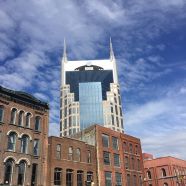Returning Home to the American South
Not long ago I returned to the South after five years on the West Coast. I spent those years traveling among the fir trees and mountains and alpine lakes, eventually finding myself called back to Nashville, the place of my birth.
There’s something about being known by family and friends that draws many Southerners back home. No matter how much I’ve changed, the people here, my people, still understand me better than any others. Whether I like it or not, and no matter how far away I go, it’s home.
Yet I often find myself confused by the South. By its people. By its values. By what it chooses to fight for and fight against.
Why does it fight so hard for an unborn child’s right to life, but seem blindsided when a person of a different race raises their hand and says, “Do you see me? Do you see us dying out here?”
Why does it protect its guns and its borders with such vigor but grow silent when women ask to be treated with decency and respect?
In his book, Travels with Charley, John Steinbeck writes, “The South is in the pain of labor with the nature of its future child still unknown.” In many ways, I sense no truer words have been spoken of the place of my birth.
The South is a dichotomy. A catch-22. A riddle within a riddle. On the one hand, the South is totally confident in what it believes, and on the other it is still trying to determine its fate. It simultaneously wants to innovate, to be a leader in a constantly developing world, and yet seems stuck in some bygone era. It looks toward the future, but remains tethered to the past.
Recently, as I drove around Nashville, I was amazed by all that had changed. New buildings on every commercial corner. Flipped houses on every residential street. Tourists lined up for miles and thousands of new residents arriving every day. A behemoth new downtown convention center.
But it was something exactly the same that struck me most: the local middle school. John Trotwood Moore has been located among the hilly suburbs of Nashville for decades. For much of that time the building has remained unchanged. The building’s façade is the same as when I practiced baseball in the fields next door in adolescence. It is the same building in which a young student was shot in 1994. The exact same building in a city where so much has changed over the decades.
Certainly buildings aren’t the only (or even the main) metric by which we grade schools. There very well could be 30 – 40 groundbreaking people teaching in that small building, changing children’s lives. Yet, the dichotomy of huge, newly built skyscrapers and small, one-story school buildings is too hard to ignore.
That’s the thing about values, we can say we value our kids, their education, their future, but when we focus our funds on huge, downtown convention centers while our school buildings fall apart, it says something. It makes clear what we do and don’t value. On the surface, we say we value one thing—but our dollars show something else.
It’s this dichotomy of values, the gap between what we say we value and our actions, that makes the South so confusing.
Take my Arab grandmother, for example. On the one hand, she is the child of Palestinian immigrants who arrived in the states through Ellis Island in the early part of the twentieth century. Her father started with nothing, making his life selling oriental rugs out of the trunk of his car and was once run out of Indiana by the Ku Klux Klan.
On the other hand, she supports a president who wants to put a wall around our country. My grandmother is the American dream, and yet she is seemingly unafraid to deny it to others.
And that, simply put, is the American South.
It’s a place still in the process of discovering itself. Still unsure what it will choose to be. Still struggling, though it will never admit this, with the pains of labor.
And yes, I came back—I guess that’s the real irony. No matter how far away I go from this catch-22 of a hometown, it’s still my place, my people, my riddle. I think that’s the thing about home—no matter how crazy or how confusing—it’s still home. This place still lives within me.
I guess the South and I really aren’t that different—still trying to figure out who we’re going to become. We’ll get there, I’m sure, but not without more labor pains along the way.







